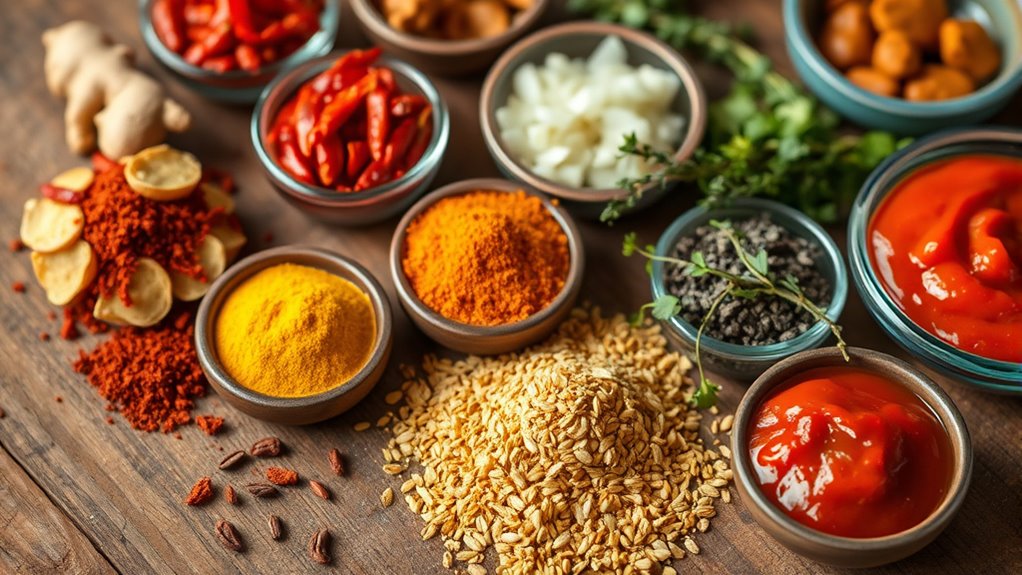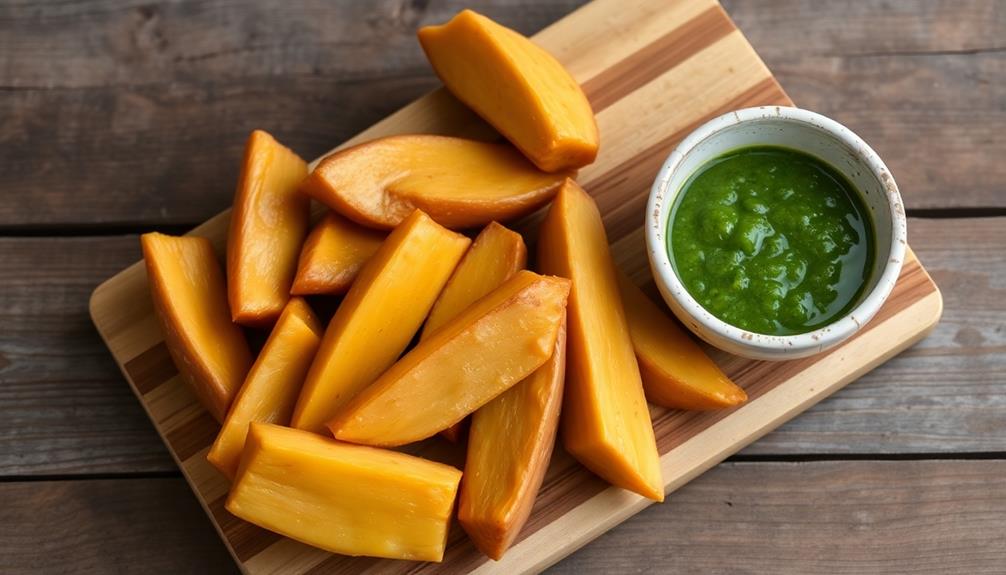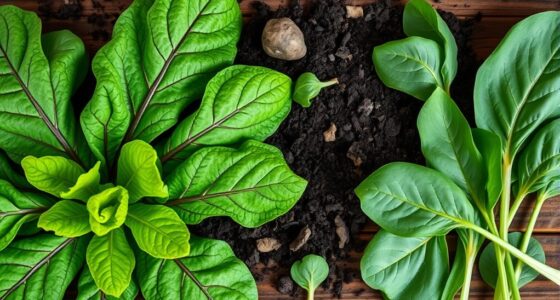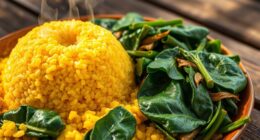To open West Africa’s rich stew flavors, focus on seven key spices: ginger, garlic, onions, chili powder or cayenne, cumin, coriander, and turmeric. These spices form the foundation, adding warmth, depth, and vibrant color. Using fresh, toasted, and well-blended spices enhances authenticity and complexity. For every step, from blending to simmering, these ingredients work together to create a signature taste. Keep exploring, and you’ll discover even more secrets behind these beloved dishes.
Key Takeaways
- Key spices include ginger, garlic, onions, chili powder, cumin, coriander, and turmeric, forming the base for authentic stews.
- Toasting whole spices like cumin and coriander enhances aroma and deepens flavor profiles.
- Regional variations feature unique spices such as suya spice, cloves, alligator pepper, and tamarind.
- Fresh, high-quality spices and proper layering during cooking are essential for rich, complex flavors.
- Incorporating spice blends at different stages builds depth and authenticity in West African stews.

West African stews are renowned for their bold, complex flavors, and the secret lies in the vibrant spices that form their foundation. When you explore cooking these dishes, you’ll quickly realize that mastering spice blending techniques is essential. These techniques involve carefully combining individual spices to create harmonious flavors that define each stew. These techniques involve carefully combining individual spices to create harmonious flavors that define each stew. You might start with a base of ground ginger, garlic, and onions, then add specific blends of chili powder, cumin, or coriander depending on the regional flavor variations you aim to achieve. Each area in West Africa has its own unique spice profile, shaped by local ingredients, climate, and cultural influences. For instance, Nigerian stews often feature a hearty mix of suya spice, while Ghanaian dishes might incorporate a fragrant blend of ginger, cloves, and alligator pepper.
Understanding regional flavor variations helps you tailor your spice blends to evoke authentic tastes. In Senegal, for example, the use of yellow mustard seeds, pink peppercorns, and a hint of tamarind creates a tangy and mildly spicy profile. Conversely, in Ivory Coast, you might focus on a combination of fresh herbs, chili, and local spices like turmeric or baobab seeds to give your stew a distinct character. Recognizing these regional differences allows you to experiment and adapt, making your cooking more authentic and personalized. Additionally, spice quality—such as freshness and grind—significantly influences the final flavor of your dishes. You can further enhance your spice blends by understanding flavor layering, which involves adding spices at different stages of cooking to build depth. Toasting whole spices before grinding not only releases their essential oils but also enhances aroma development, leading to a richer taste experience in your stew. Incorporating techniques like toasting spices can unlock deeper flavor profiles that elevate your dishes. When you prepare your spices, think about how they interact during cooking. Toasting whole spices before grinding enhances their aroma and deepens their flavor, giving your stew a richer taste. Combining spices in advance—either by dry roasting or blending into a powder—ensures a well-rounded flavor distribution in your dish. Keep in mind that the proportions matter; too much chili can overpower, while a touch of cinnamon or nutmeg can add surprising depth. You’ll also want to consider how long you cook your spices; some release their flavors quickly, while others need longer simmering to fully develop.
Frequently Asked Questions
Which Spice Is Most Iconic in West African Stews?
Imagine a vibrant tapestry woven with fiery reds and warm earth tones—that’s the essence of West African stews. The most iconic spice, often a bold pinch of ginger or smoked paprika, brings this picture to life. You’ll notice traditional spice preparation and blending techniques that elevate these flavors, making each stew a symphony of taste. Ginger, with its zesty punch, stands out as the star of West African stews.
How Do Regional Differences Affect Spice Blends?
Regional herb variations markedly influence spice blend adaptations in West African stews. You’ll notice that coastal areas favor more seafood-friendly herbs, while inland regions use heartier spices like ginger and chili. These differences shape each area’s unique flavor profile, so you can expect subtle but impactful variations in spice blends. By understanding regional influences, you’ll appreciate how local ingredients and tastes shape each stew’s distinct character.
Are There Any Spice Substitutions for Allergies?
If you have allergies, you might wonder about allergy-friendly spice swaps and alternative spice options. You can replace common allergens like cumin or coriander with safe choices such as smoked paprika, turmeric, or dried herbs like thyme and oregano. Always check labels and test small amounts first to make certain there’s no reaction. This way, you can enjoy flavorful stews without risking allergic reactions, making your cooking both safe and delicious.
What Is the History Behind West African Spice Use?
Imagine ancient trade routes weaving through West Africa like vibrant arteries, carrying spices that infused local cuisines with life. You learn that spice cultivation flourished as traders exchanged fragrant treasures, shaping culinary traditions over centuries. These spices tell stories of cultural exchange and resilience, transforming simple ingredients into soulful stews. The history behind West African spice use is a rich tapestry of trade, innovation, and community that continues to spice up your palate today.
How Do Spices Influence the Flavor Profile of Stews?
Spices play a key role in shaping your stew’s flavor profile by adding rich aroma and depth. When you incorporate spices, they release a mesmerizing spice aroma that instantly elevates the dish. These spices also enhance flavor, balancing savory and spicy notes while highlighting other ingredients. Your choice of spices influences the overall taste, making each bite more complex and satisfying. Ultimately, spices are essential for creating a memorable, flavorful stew experience.
Conclusion
Next time you enjoy a West African stew, remember these seven spices are more than just ingredients—they’re the secret to its rich, vibrant flavor. Some believe the use of spices like ginger and cumin hints at ancient trade routes connecting West Africa to distant lands, adding a layer of history to your meal. So, when you savor these stews, you’re tasting centuries of cultural exchange and culinary mastery in every bite.










